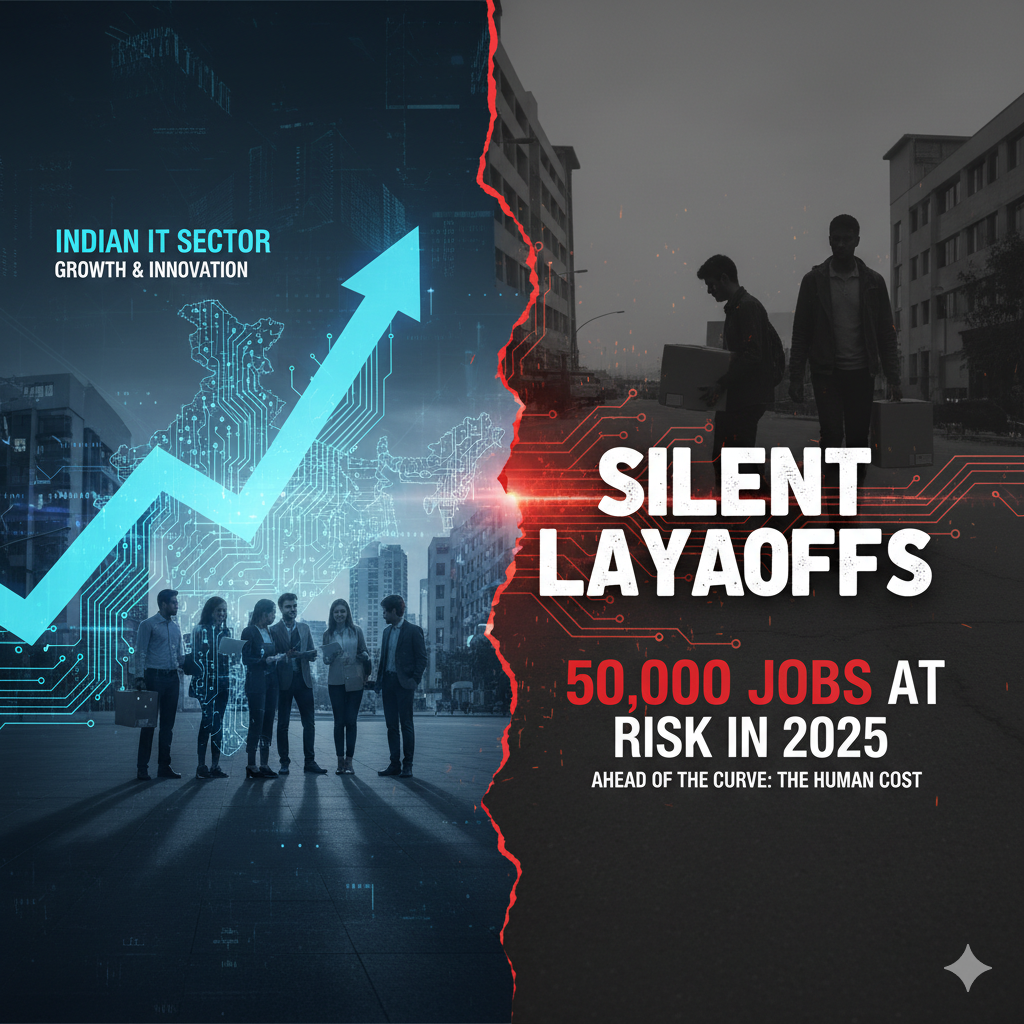Indian IT Sector Hit by Silent Layoffs: 50,000 Jobs at Risk in 2025
A Sudden Shift in India’s Tech Landscape
The Indian IT industry — once the country’s most stable career avenue — is now experiencing a quiet storm. While headlines celebrate the rise of AI, digital transformation, and global expansion, an unsettling trend is emerging beneath the surface: silent layoffs.
Experts estimate that nearly 50,000 IT professionals could lose their jobs in 2025, not through mass termination announcements, but through subtle, gradual workforce reductions that often go unnoticed.
This silent shift is reshaping India’s $250-billion technology sector — and it’s a wake-up call for both employers and employees to adapt fast.

What Are Silent Layoffs?
Silent layoffs don’t make the front page. Unlike traditional layoffs that come with press releases and official HR memos, these are quiet exits.
Employees may find themselves:
- Removed from projects without reassignment
- “Encouraged” to resign voluntarily
- Not having their contracts renewed
- Or subtly excluded from upskilling programs and performance reviews
This creates uncertainty, fear, and mistrust — not just among those affected, but across teams. For professionals who’ve built careers in IT services, this trend feels both unfamiliar and unsettling.
Why Are They Happening Now?
Several major forces are driving these silent layoffs in India’s IT sector:
1. AI and Automation Are Changing the Game
AI tools are now handling tasks once done by human developers, testers, and support staff. From automated code generation to chatbot-based customer support, many repetitive roles are becoming redundant.
Even major firms like Infosys, TCS, and Wipro are prioritizing AI-driven productivity over large headcounts. In short: the same work is getting done with fewer people.
2. Cost Pressures from Global Clients
US and European clients — the lifeblood of India’s IT exports — are tightening budgets and demanding more value per dollar. As margins shrink, companies are quietly trimming non-essential or low-performing teams.
3. Skill Mismatch and Reskilling Gaps
The industry is rapidly shifting toward cloud computing, cybersecurity, and AI-driven analytics. Many mid-level professionals who haven’t reskilled are struggling to stay relevant. Instead of firing directly, firms often use “performance-based exits” as a polite disguise for skill mismatch.
4. Economic Uncertainty and Hiring Freezes
Global inflation, fluctuating exchange rates, and geopolitical tensions have forced IT companies to play it safe. Hiring is frozen, promotions are delayed, and existing employees are quietly let go to balance costs.

The Real Impact: 50,000 Jobs at Risk
Industry insiders estimate that around 50,000 IT jobs could disappear by mid-2025, especially in non-AI-aligned roles such as:
- Quality Assurance (manual testing)
- BPO and support desks
- Legacy software maintenance
- Low-level coding and documentation tasks
While new AI-driven roles are being created, the transition is uneven. Many professionals are losing their footing before they can upskill.
For fresh graduates entering the job market, it means more competition and fewer entry-level openings. For mid-career employees, it means the urgency to adapt — or risk becoming obsolete.
How Jobseekers Can Survive the Silent Layoff Wave
The good news: the future still belongs to those who evolve.
Here’s how Indian IT professionals can stay relevant in 2025 and beyond:
✅ 1. Learn AI & Automation Tools
Don’t fear AI — work with it. Learn tools like ChatGPT APIs, TensorFlow, Microsoft Copilot, or data visualization platforms. Companies want employees who can leverage automation, not compete against it.
✅ 2. Upskill in High-Demand Areas
Invest in certifications related to:
- Cloud (AWS, Azure, GCP)
- Cybersecurity
- Data science & analytics
- DevOps and AI integration
These are the skills shaping tomorrow’s IT workforce.
✅ 3. Build a Visible Online Portfolio
Keep your LinkedIn updated. Showcase projects, open-source contributions, and client testimonials. Recruiters increasingly rely on verified job profiles — platforms like JobsVerifier.com ensure your skills and job history are credible.
✅ 4. Be Flexible with Roles and Work Models
Remote and hybrid work have blurred traditional job boundaries. Be open to freelance projects, contractual positions, or cross-domain roles that keep your income steady and your experience diverse.
How Companies Should Respond
Silent layoffs may seem convenient, but they often harm long-term brand reputation. Smart companies are taking a more sustainable approach:
💡 Invest in Reskilling, Not Replacement
Rather than letting go of loyal employees, firms should invest in training programs that transition them into AI-ready roles. Upskilled employees become assets, not liabilities.
💡 Be Transparent About Organizational Changes
Hidden layoffs create fear and disengagement. Transparent communication fosters trust and improves morale — even in tough times.
💡 Use Verified Hiring Channels
Job fraud, fake offers, and unverified postings are on the rise. Platforms like JobsVerifier help employers connect with genuine talent and maintain credibility in recruitment.
The Bigger Picture: From Threat to Transformation
Yes, 50,000 jobs are at risk — but India’s IT industry is not collapsing. It’s transforming.
Just as automation replaced typewriters but created software jobs, AI and robotics will phase out some roles but open others. The challenge lies in bridging the skill gap fast enough.
By 2030, India is projected to become a global AI talent hub, provided the workforce adapts. Silent layoffs, in this sense, are not just losses — they’re signals that the next era of IT has arrived.
Final Thoughts
The Indian IT sector stands at a crossroads. The quiet restructuring we see today could either become a national employment crisis — or a strategic rebirth of talent.
For professionals, the message is clear: evolve or be replaced.
For companies, it’s: be honest, train your people, and build sustainable tech teams.
In this changing landscape, verified hiring platforms like JobsVerifier.com serve a crucial purpose — connecting genuine employers with verified, future-ready candidates while promoting transparency in an uncertain job market.
Silent layoffs may be “quiet,” but the message is loud and clear:
The future of India’s IT industry will belong to those who learn, adapt, and lead.


